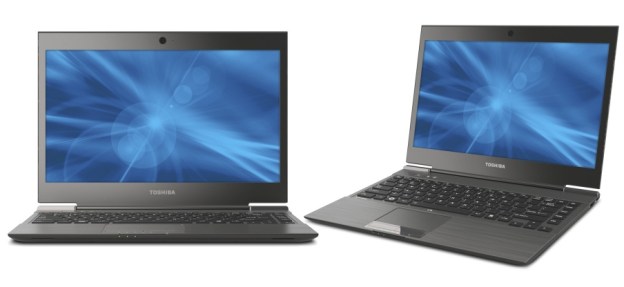 The MacBook Air is about to get a lot of competition. Just the other day, Asus announced half a dozen of its own super-thin “Ultrabook” laptops, based on specifications set by Intel. Now Toshiba wants in. Today, the company unveiled the 13-inch Portege Z830, its thinnest and lightest laptop yet. Weighing in at a scant 2.5 pounds and measuring just 0.63 inches thick (closed), the Z830 is 20 percent thinner and 40 percent lighter than Toshiba’s R830 series, which debuted back in April.
The MacBook Air is about to get a lot of competition. Just the other day, Asus announced half a dozen of its own super-thin “Ultrabook” laptops, based on specifications set by Intel. Now Toshiba wants in. Today, the company unveiled the 13-inch Portege Z830, its thinnest and lightest laptop yet. Weighing in at a scant 2.5 pounds and measuring just 0.63 inches thick (closed), the Z830 is 20 percent thinner and 40 percent lighter than Toshiba’s R830 series, which debuted back in April.
As with all Ultrabooks, this machine has flash internal storage instead of a hard drive (that means it’s fast), runs Windows 7, and is based on Intel’s second-generation Core processors (i3, i5, and i7). Toshiba has also included its own sleep/hibernate charging mode, which lets you charge a phone or other USB device while the computer is in stasis.

We spoke with Kelcey Kinjo, product manager at Toshiba, who told us about a number of enhancements that Toshiba included to try and blur the line between business and consumer laptops. Unlike most consumer laptops, this will have a backlit keyboard that is also spill resistant and also includes some different drop protection technologies. The new Portege will include air pockets in the design, has a more rigid honeycomb-like frame out of magnesium alloy, and achieves better airflow by pulling key components together. Also, to maximize battery life, the Intel battery in the Z830 is not removable. Disappointing, yes, but the design decision allowed Toshiba to include an 8-cell battery, 20 percent larger than what it could have included with a removable design. Users should expect about 8 hours of life, which is great for a Windows laptop.
The 128GB Portege Z830 will be available this November. We weren’t able to nail down a price, but it will be “less than $1000,” said Kinjo.

